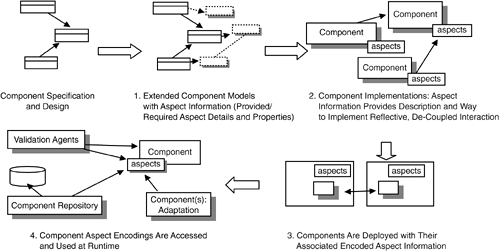Section 25.3. OUR APPROACH
25.3. OUR APPROACHWe have developed aspect-oriented component engineering, a new method for developing software components with aspects. The use of aspects provides us with "multiple perspectives" on software component designs. Figure 25-3 illustrates our approach. Component specifications and designs, typically UML diagrams, are augmented with aspect information (1). A key activity is determining whether required aspects are met in proposed component configurations. We also check whether component configurations are consistent with respect to the aspect constraints. When implementing designs, we use the aspect information to help us develop a more decoupled component interaction and dynamic component configuration. This enables us to maximize the amount of component reuse and dynamic component adaptation possible (2). We encode the aspect information about software components in a run-time accessible form (3). At runtime, this information allows components to be introspectedthat is, understood by end users and other components. We use this encoded aspect-based information to support dynamic run-time component reconfiguration and adaptation. We have also used it to support component storage and retrieval from a repository and component validation by dynamic test generation and execution (4). Figure 25-3. An overview of aspect-oriented component engineering. In the following three sections, we briefly illustrate how we use aspects for component design, for decoupled and configurable component implementation, and at runtime. |
EAN: 2147483647
Pages: 307